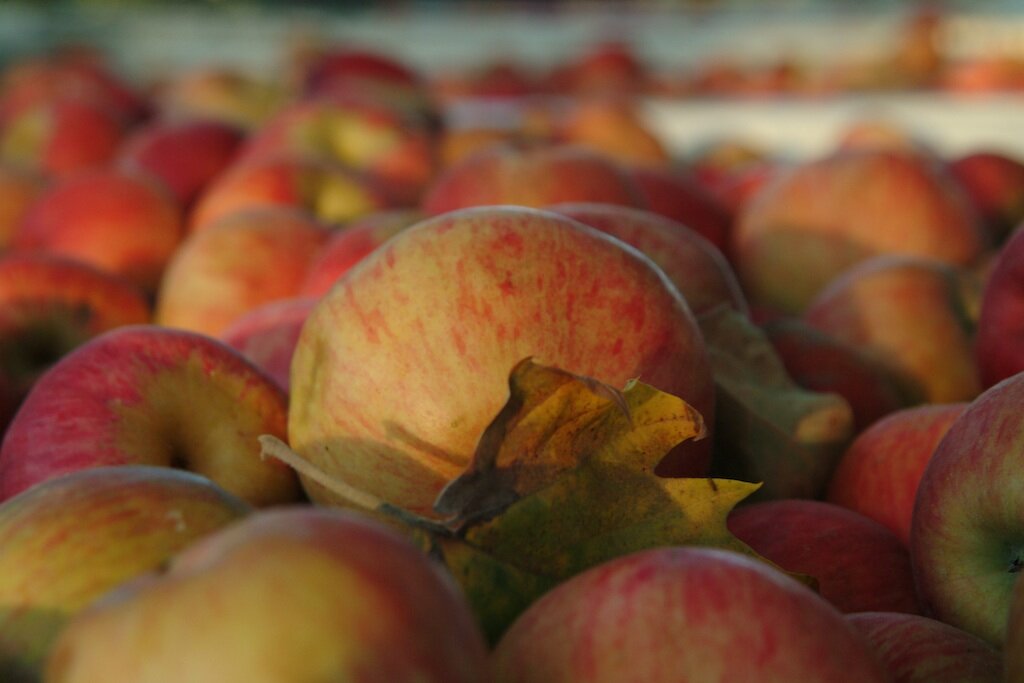
Apples
Gravensteins in the Russian River Valley
– Jock Soper, Healdsburg, CA
When Russian explorers arrived in northern California in 1811, they planted grapes, and they planted apples. Both remain as part of the modern agricultural mix of Sonoma County, with grapes now more famous than apples. But among the vineyards, you can still find orchards of Gravenstein apple trees.
Slow Food USA, the domestic branch of the global movement to preserve local foods and flavors, has placed the Gravenstein Apple into its “Ark of Taste”, a biblical reference to saving precious things from the flood of industrialization. The proud Gravenstein shares the Ark with notable, but endangered, California fruits like the Blenheim Apricot, the Crane Melon, and the Meyer Lemon.
The exact origins of the Gravenstein Apple are lost in the mists of antiquity. The Russians may have found theirs at home, or in Italy, or in a rich farming region in the old German-Danish border lands. We know more certainly that the orchards of the Russian River Valley were planted with seeds and saplings from the old Russian orchard at Fort Ross. Later, legendary horticulturist Luther Burbank promulgated Gravensteins from his nurseries near Santa Rosa.
The Gravenstein Apple is red and green together, crisp, juicy, with both sweetness and tart acid accents – perfect for applesauce, apple pie, for salads, or for eating in hand with your picnic cheese and wine. One historian of apple culture reports that Gravensteins are one of the few apples that have “personality.” But the apples ripen early, grow close to the branch with short stems that make them a little hard to pick, and the thin skins mean they don’t store or ship as well as some of their better-known cousins.
The historical importance of Gravenstein orchards to the social and economic history of Sonoma County is unquestioned. With Sebastopol as the apple epicenter, you will find Gravenstein Station along the old Petaluma and Santa Rosa railway, where the apples were freighted out to the markets of America. You will drive along the Gravenstein Highway to arrive at the annual (August) Gravenstein Apple Fair. But, from about 8,000 acres of orchards after World War II, the region is down to only 960 acres. In the old days, Gravenstein apples grew on every farmstead. Today there are only a half dozen growers remaining, the best known of whom are the Dutton family. Many of the apple trees in Dutton orchards date back to the 1920’s, although replacement plantings are ongoing.
Dutton Ranch currently farms about 180 acres of CCOF certified organic apples, which in 2021 produced around 3704 tons, including approximately 1500 tons (35%) of Gravensteins. The Duttons raise several varieties in addition to the Gravensteins, including Golden Delicious, Jonathan, McIntosh and Rome Beauty.
The majority of the Dutton family Gravenstein apple crop, commencing in late July, is committed to one of the last small, independent fruit processors in Sonoma County, Manzana Products Co. of Sebastopol. There, the pristine apples are turned into organic apple juice and applesauce, ultimately finding their way to the shelves of grocers such as Whole Foods and Trader Joe’s.
If you visit the Russian River Valley in late summer or early fall, you will find freshly-picked native Gravenstein apples for sale in farmers’ markets, local groceries, and in classic old-style fruit and vegetable stands along our quiet country roads. Pull over and bite into a piece of Russian River Valley history.

